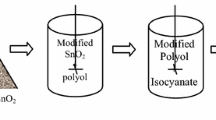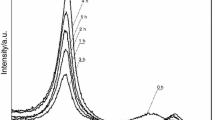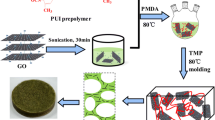Abstract
High thermally stable polyurethane-based nanocomposite (PU) foam reinforced with different (0.25 - 1.0) wt% of carbonaceous nanofillers, i.e., graphene oxide (GO), reduced graphene oxide (rGO), and carbon black (CB) with polydimethylsiloxane (PDMS), were prepared by melt blending method. PU nanocomposite foam was tested and characterized by several techniques to check its stability and suitability for use at high temperatures. The microstructure of PU nanocomposite foam was studied by Field Emission Electron Microscopy (FESEM). The phase separation and crystallinity of samples were analyzed by X-ray diffraction technique. The tensile strength and extension properties were evaluated. The tensile strength of PU-PDMS with 1.0 wt% GO was 58.9% more than that of neat PU-PDMS. The thermal properties of PU foam were investigated using a Thermogravimetric Analyser (TGA). At 650 °C temperature, PU foam having 1.0 wt% of the carbonaceous-based nanofillers (GO, CB and rGO) is more thermally stable than other wt.% of nanofillers and could be used for high-temperature applications.
Similar content being viewed by others
Data Availability
The data presented in this study are available on request from the corresponding author.
References
Liang G, Zheng L, Zhu N, Gu A (2018) 11 - dielectric polymer materials with high thermal stability. In: Dang Z-M (ed) Dielectric polymer materials for high-density energy storage. William Andrew Publishing, pp 383–427
Król-Morkisz K, Pielichowska K (2019) 13 - thermal decomposition of polymer nanocomposites with functionalized nanoparticles. In: Pielichowski K, Majka TM (eds) Polymer composites with functionalized nanoparticles. Elsevier, pp 405–435
Feng L, Zhang X, Dai J, Ge Z, Chao J, Bai C (2008) Synthesis and surface properties of polyurethane modified by polysiloxane. Front Chem China 3:1–5
Zhao H, Hao T-H, Hu G-H, Shi D, Huang D, Jiang T, Zhang Q-C (2017) Preparation and characterization of polyurethanes with cross-linked siloxane in the side chain by sol-gel reactions. Materials 10:247
Zhang Z-P, Song X-F, Cui L-Y, Qi Y-H (2018) Synthesis of polydimethylsiloxane-modified polyurethane and the structure and properties of its antifouling coatings. Coatings 8:157
Adak B, Joshi M, Butola BS (2019) Polyurethane/functionalized-graphene nanocomposite films with enhanced weather resistance and gas barrier properties. Compos B Eng 176:107303
Demharter A (1998) Polyurethane rigid foam, a proven thermal insulating material for applications between+ 130 C and− 196 C. Cryogenics 38:113–117
Jin F-L, Zhao M, Park M, Park S-J (2019) Recent trends of foaming in polymer processing: a review. Polymers 11:953
Chen X, Li J, Gao M (2019) Thermal degradation and flame retardant mechanism of the rigid polyurethane foam including functionalized graphene oxide. Polymers 11:78
Mehta S, Hatwalne M, Dhule M (2014) Characterization of PU Foam for High Temperature Applications in Automobiles. SAE Technical Paper (No. 2014-01-1035). https://doi.org/10.4271/2014-01-1035
Zia F, Zia KM, Aftab W, Tabasum S, Mohammadi M, Zuber M (2020) Synthesis and characterization of graphene nanoplatelets-hydroxyethyl cellulose copolymer-based polyurethane bionanocomposite system. Int J Biol Macromol 165:1889–1899
Shin S-R, Lee D-S (2022) Nanocomposites of rigid polyurethane foam and graphene Nanoplates obtained by exfoliation of natural graphite in polymeric 4, 4′-Diphenylmethane Diisocyanate. Nanomaterials 12:685
Verdolotti L, Di Caprio MR, Lavorgna M, Buonocore GG (2017) Polyurethane nanocomposite foams: Correlation between nanofillers, porous morphology, and structural and functional properties. Polyurethane polymers, Elsevier, pp 277-310. https://doi.org/10.1016/B978-0-12-804065-2.00009-7
Pergal M, Džunuzović J, Ostojić S, Pergal MM, Radulović A, Jovanovic S (2012) Poly (urethane-siloxane) s based on hyperbranched polyester as crosslinking agent: synthesis and characterization. J Serbian Chem Soc 77:919–935
Ekin A, Webster DC, Daniels JW, Stafslien SJ, Cassé F, Callow JA, Callow ME (2007) Synthesis, formulation, and characterization of siloxane–polyurethane coatings for underwater marine applications using combinatorial high-throughput experimentation. J Coat Technol Res 4:435–451
Zia KM, Waseem-ul-Arifeen IMA, Zuber M, Ishaq M, Farrukh MA, Ahmad MN (2015) Synthesis and characterization of polydimethyl siloxane-based polyurethane elastomers using toluene diisocyanate. J Elastomers Plast 47:669–680
Chun Y-C, Kim K-S, Shin J-S, Kim K-H (1992) Synthesis and characterization of poly(siloxane-urethane)s. Polym Int 27:177–185
Stefanović IS, Spirkova M, Poręba R, Steinhart M, Ostojić S, Tešević V, Pergal MV (2016) Study of the properties of urethane–siloxane copolymers based on poly (propylene oxide)-b-poly (dimethylsiloxane)-b-poly (propylene oxide) soft segments. Ind Eng Chem Res 55:3960–3973
Zhao J, Xu R, Luo G, Wu J, Xia H (2016) Self-healing poly (siloxane-urethane) elastomers with remoldability, shape memory and biocompatibility. Polym Chem 7:7278–7286
Maldonado-Magnere S, Yazdani-Pedram M, Aguilar-Bolados H, Quijada R (2020) Thermally reduced graphene oxide/thermoplastic polyurethane nanocomposites: mechanical and barrier properties. Polymers 13:85
Mandal S, Roy D, Prasad NE, Joshi M (2021) Interfacial interactions and properties of cellular structured polyurethane nanocomposite based on carbonaceous nano-fillers. J Appl Polym Sci 138:49775
Li A, Zhang C, Zhang Y-F (2017) Thermal conductivity of graphene-polymer composites: mechanisms, properties, and applications. Polymers 9:437
Lawal AT (2020) Recent progress in graphene based polymer nanocomposites. Cogent Chem 6:1833476
Yousefi N, Gudarzi MM, Zheng Q, Lin X, Shen X, Jia J, Sharif F, Kim J-K (2013) Highly aligned, ultralarge-size reduced graphene oxide/polyurethane nanocomposites: mechanical properties and moisture permeability. Compos Part A: Appl Sci Manuf 49:42–50
Jaiswal R, Agarwal K, Pratap V, Soni A, Kumar S, Mukhopadhyay K, Prasad NE (2020) Microwave-assisted preparation of magnetic ternary core-shell nanofiller (CoFe2O4/rGO/SiO2) and their epoxy nanocomposite for microwave absorption properties. Mater Sci Eng B 262:114711
Zhong W, Ding X, Li W, Shen C, Yadav A, Chen Y, Bao M, Jiang H, Wang D (2019) Facile fabrication of conductive graphene/polyurethane foam composite and its application on flexible piezo-resistive sensors. Polymers 11:1289
Strankowski M, Włodarczyk D, Piszczyk Ł, Strankowska J (2016) Polyurethane nanocomposites containing reduced graphene oxide, FTIR, Raman, and XRD studies. J Spectrosc 2016. https://doi.org/10.1155/2016/7520741
Strankowski M, Korzeniewski P, Strankowska J, Anu AS, Thomas S (2018) Morphology, mechanical and thermal properties of thermoplastic polyurethane containing reduced graphene oxide and graphene nanoplatelets. Materials 11:82
Li S, Chen Y, He X, Mao X, Zhou Y, Xu J, Yang Y (2019) Modifying reduced graphene oxide by conducting polymer through a hydrothermal polymerization method and its application as energy storage electrodes. Nanoscale Res Lett 14:1–12
Pooladian B, Nikje MMA (2018) Preparation and characterization of novel poly (urethane-imide) nanocomposite based on graphene, graphene oxide and reduced graphene oxide. Polym Plast Technol Eng. https://doi.org/10.1080/03602559.2018.1434669
Wei-Hao L, Yang S-Y et al (2013) Effect of molecular chain length on the mechanical and thermal properties of amine-functionalized graphene oxide/polyimide composite films prepared by in situ polymerization. ACS Appl Mater Interfaces. https://doi.org/10.1021/am302494c
Acknowledgments
The authors are grateful to Namburi Eswara Prasad, the Director, DMSRDE Kanpur, and Debmalya Roy, the Directorate Head of Nanomaterials, DMSRDE Kanpur, for their guidance and valuable suggestions. The authors express their sincere thanks to Nano Material Division, DMSRDE Kanpur, India, for providing the experimental facility. The authors also acknowledge the Motilal Nehru National Institute of Technology Allahabad, Prayagraj, India, for providing financial support.
Author information
Authors and Affiliations
Contributions
Ganesh Yadav: Conceptualization, Investigation, Sunil Kumar Gupta: Formal analysis, Methodology, Kartikey Singh: Writing—original draft, Scheme design, Visualization, Rimpa Jaiswal: review & editing, Zacharia T J: review & editing, Kavita Agarwal: Conceptualization, Methodology, resources, Formal analysis, review & editing. All authors read and approved the final manuscript.
Corresponding author
Ethics declarations
Ethics Approval
Not applicable.
Consent to Participate
Not applicable.
Consent for Publication
Consent for publication has been given by DMSRDE, Kanpur.
Competing Interests
The authors have no relevant financial or non-financial interests to disclose.
Conflict of Interest
The authors declare that they have no conflicts of interest.
Additional information
Publisher’s Note
Springer Nature remains neutral with regard to jurisdictional claims in published maps and institutional affiliations.
Supplementary Information
ESM 1
(DOCX 1159 kb)
Rights and permissions
Springer Nature or its licensor (e.g. a society or other partner) holds exclusive rights to this article under a publishing agreement with the author(s) or other rightsholder(s); author self-archiving of the accepted manuscript version of this article is solely governed by the terms of such publishing agreement and applicable law.
About this article
Cite this article
Yadav, G., Gupta, S.K., Singh, K. et al. High Thermally Stable Polyurethane Nanocomposite Foam Containing Polydimethyl Siloxane and Carbonaceous Nanofillers. Silicon 15, 2869–2878 (2023). https://doi.org/10.1007/s12633-022-02212-6
Received:
Accepted:
Published:
Issue Date:
DOI: https://doi.org/10.1007/s12633-022-02212-6




